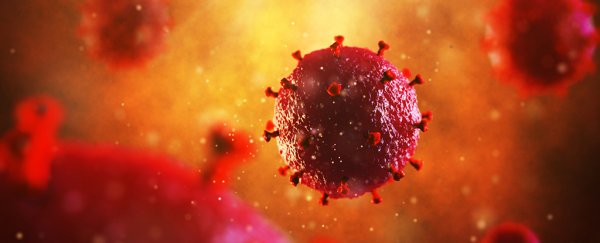Ever since the world woke to the unfolding tragedy of the AIDS epidemic, we've been desperate to solve the problem of removing all traces of the human immunodeficiency virus ( HIV) from a human body.
A dual-punch approach that combines gene editing with targeted drugs could be the trick we need, if the latest mouse study is any indication - it demonstrated a successful cure in five out of 13 transgenic mice, leaving many excited.
The HIV virus is a true master of disguise, transforming its appearance as it proliferates inside the human body. Even if all else fails, the virus can hide its genetic template inside our own DNA, ready to emerge when the heat dies off.
Thanks to this talent for staying low, the best we can do is strike with an arsenal of pharmaceuticals designed to keep the deadly pathogen underground, preventing it from emerging and ravaging the body's immune system. Going off antiretroviral drugs for as little as a few weeks risks a resurgence of infectious virus particles.
Researchers from the University of Nebraska Medical Center and Temple University in the US have demonstrated the genetic editing technology CRISPR-Cas9 is theoretically capable of finding those buried virus genes and destroying them in mice engineered to have human biochemistry.
CRISPR couldn't accomplish this all on its own. The team had to pair it with long-acting, slow effective release antiretroviral therapy to give the genetic surgery the time it needed to hunt out the viral genes and destroy them.
If we could apply the same approach to people, it would mean the potential for abandoning daily retroviral medication and the variety of uncomfortable side effects the drugs come with. Given that nearly 40 million people around the world are currently living with the virus, such a cure would be an exciting development.
Unfortunately, CRISPR gene editing is still in its infancy as a medical technology, and we still don't have a good grasp of how much harm it might cause inside a human body.
But compared with earlier methods for targeting genetic sequences for removal or dissection, CRISPR can be easily programmed for an unprecedented level of precision.
This makes it a sexy tool for any researcher keen to perform microsurgery on a molecular level. Just provide it with the sequence you want chewed up, and send it in.
There are already designs on using it to remove other buried viruses, such as herpes, not to mention the first tentative steps towards editing the genes behind congenital conditions such as heritable heart diseases.
But the technology hasn't come without intense controversy.
Even if we put aside questions on the ethics of using it to change our own genes, there have been concerns that the CRISPR hardware isn't as clean cut as we might have hoped, potentially giving rise to changes that would raise the risk of cancer.
In context, any therapy based on such a problematic technology becomes a question of risk versus the likelihood of success.
It typically takes just a few days for HIV to reemerge in untreated transgenic mice. But eight weeks after going treatment-free there was no trace of the virus's genes in five out of 13 infected subjects, implying a drug-free future for at least a lucky few.
Needless to say, even mice engineered to mimic our bodies are no substitute for actual humans. Trials underway on primates could go a little further in demonstrating just how much hope we should hold out for CRISPR as a way forward for HIV treatment.
The question is, will we be testing this on ourselves any time soon?
The US Food and Drug Administration has been hesitant granting permission in the past. Earlier last year, it denied a biotech company's request to progress with research on a CRISPR-based sickle cell anaemia treatment.
But it does happen. Come December, another company was given the green light to use the approach in a trial for curing a childhood blindness.
Without delving too deeply into the details behind individual calls, it's clear that administrators in the US are viewing the technology with more than a small degree of caution. As they should.
But HIV research has already had a history of being forced to wait. Wind back the clock just a few decades, a positive test for HIV was a death sentence. Tragically, for millions around the globe denied access to medication, it still is.
The final step towards a cure would be something to celebrate, but for now, time will tell if this is the one we've been hoping for.
This research was published in Nature Communications.
